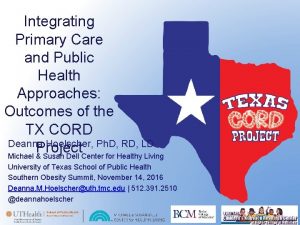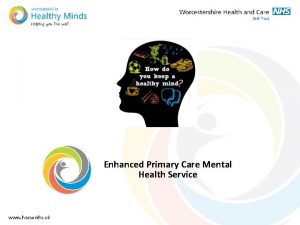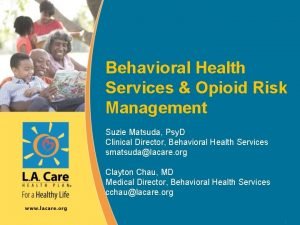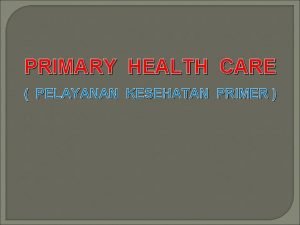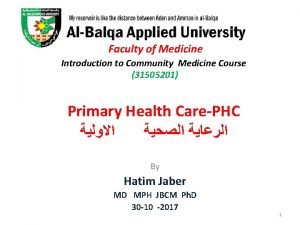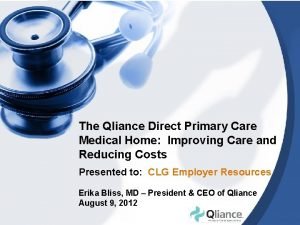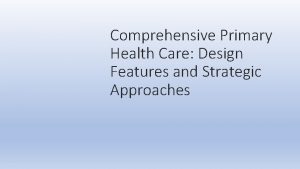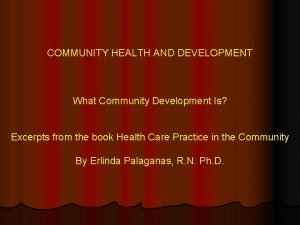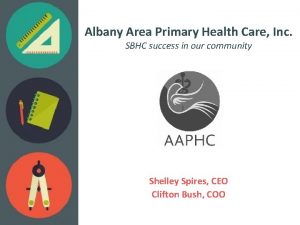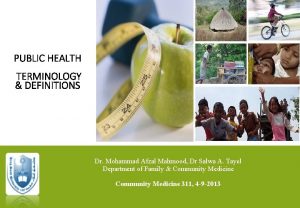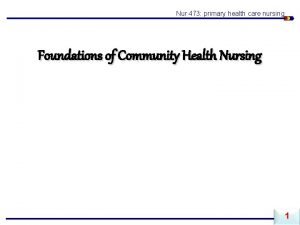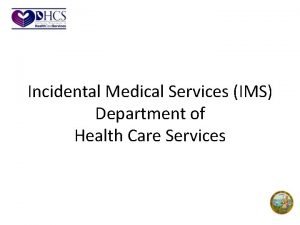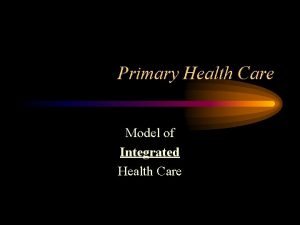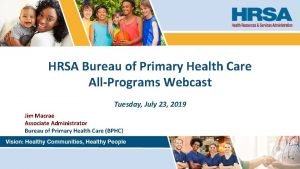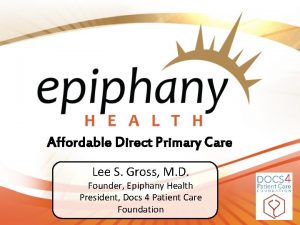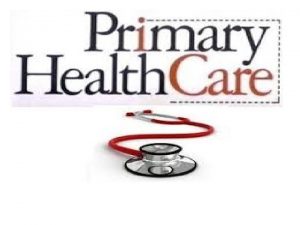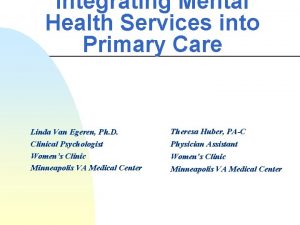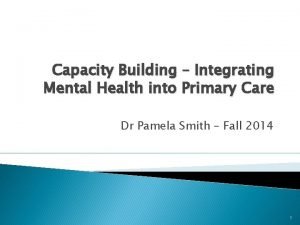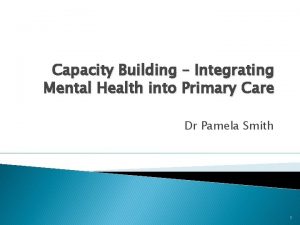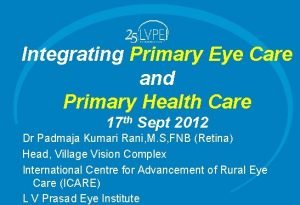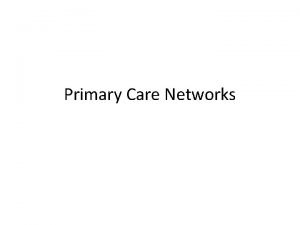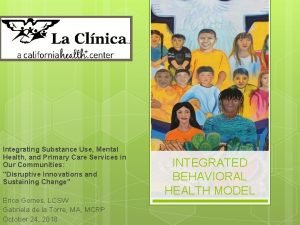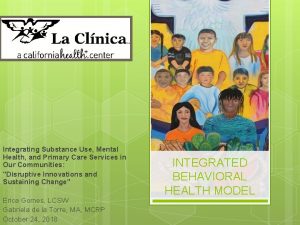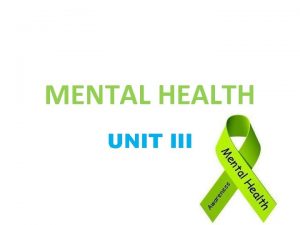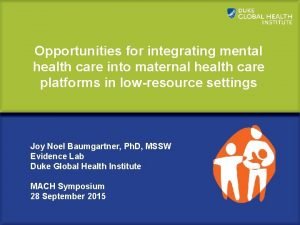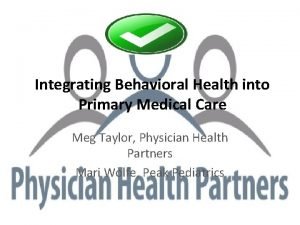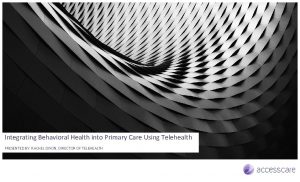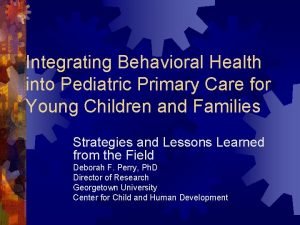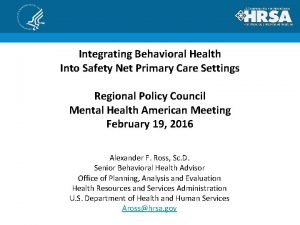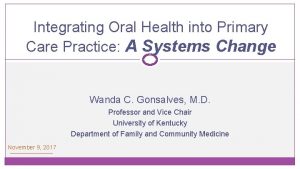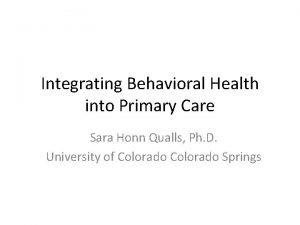Integrating Childhood Mental Health into Primary Care Pediatrics








































- Slides: 40

Integrating Childhood Mental Health into Primary Care Pediatrics Brian Gannon, MD, FAAP April Kendrick, Ph. D. , ECMH-E Stacey Daugherty, LICSW

THANK YOU TO OUR PARTNERS

DISCLAIMER The views, opinions, and content expressed in this presentation do not necessarily reflect the views, opinions, or policies of the Center for Mental Health Services (CMHS), the Substance Abuse and Mental Health Services Administration (SAMHSA), or the U. S. Department of Health and Human Services (HHS).

Presentation Outline • Project Overview • Project Activities • Project Evaluation • Where are We Now?

Project Overview

What is Project LAUNCH? • Project LAUNCH (Linking Actions for Unmet Needs in Children's Health) is a federal grant program administered by the Substance Abuse and Mental Health Services Administration (SAMHSA). • Project LAUNCH funding supports services to children and families, supports early childhood systems coordination, and supports early childhood workforce capacity building. • Funding is provided through five-year competitively awarded grants to states, tribes, and territories serving children and families in diverse settings. • The majority of grant funds are passed from the state/territorial/tribal level to a local pilot community.

L A U N C H M A P

Project LAUNCH’s Overarching Goal Promote the physical, social, emotional, cognitive, and behavioral health of young children from birth to eight years of age.

Guiding Principles Holistic Perspective • Encompasses the physical, social, emotional, cognitive, and behavioral health of all children from birth to age eight Ecological Framework Public Health Approach • Gives attention to all settings that influence children’s health and wellbeing • Focuses on improving all systems and incorporates prevention and health promotion activities

Project LAUNCH Activities Definitions, Strategies, and Local LAUNCH Activities

Five Prevention & Promotion Strategies Screening and assessment in a range of childserving settings Integration of behavioral health into primary care Enhanced home visiting with a focus on social and emotional well-being Mental health consultation in early care and education Family strengthening and parent skills training

What is screening and assessment? The early identification of developmental and behavioral concerns in children from birth to age eight, using validated instruments and tools, and addressing identified concerns early. * Survey of Well-being of Young Children (SWYC) *Ages and Stages Questionnaire (ASQ) Screening and assessment in a range of child-serving settings

Why are screening and assessment important to support children’s well-being? Screening and assessment in a range of child-serving settings Approximately one in every seven children in the United States faces a developmental 1 disability or disabling behavior problem before the age of 18. Yet, less than half of these children are identified before 2 they start school. 1, 2. Centers for Disease Control and Prevention, Developmental Monitoring and Screening, 2011, www. cdc. gov

Screening and assessment in a range of child-serving settings Project LAUNCH Efforts Use of valid screening tools and protocols Parent education regarding the importance of screening and screening results Training for providers on screening and assessment using valid tools Referral to appropriate services, follow-up, and ongoing care coordination Systemic efforts to implement universal screening

Local Screening and Assessment Efforts • Developmental Screening Events • Physician and Community Outreach • Professional Development • 63, 420 screeners completed in the State of Alabama • 4, 506 families served through Help Me Grow enrollment • Over 43, 000 books provided to children in Tuscaloosa County

Why is family strengthening important to support children’s well-being? Family strengthening and parent skills training Relationships between children and their primary caregivers are believed to 10 be the most important buffer for children facing early adversity. Young children’s relationships with their parents and other primary 11 caregivers lay the foundation for children’s growth. Family strengthening has been shown to contribute to positive effects in children’s cognitive, social, emotional, and physical development; children’s safety; parenting attitudes and knowledge; parenting behavior; family functioning; and families’ economic self-sufficiency. 12 10, 11. World Health Organization, 2004. The importance of caregiver–child interactions for the survival and healthy development of young children A Review. 12. Layzer, J. I. , Goodson, B. D. , Bernstein, L. , & Price, C. (2001). National Evaluation of Family Support Programs. Final Report Volume A: The Meta-Analysis.

Family strengthening and parent skills training Project LAUNCH Efforts Evidence-based parenting education and skills training Education to increase understanding of parenting and child development Linkages to services and resources to help improve overall family functioning Support from program staff as well as peer-topeer support among parents Efforts to build parents’ leadership and advocacy skills

What is mental health consultation? A consultative model to support the social-emotional development of young children within early care and education settings. Mental health consultation in early care and education

Why is mental health consultation important to support children’s well-being? An estimated 9. 5 percent to 14. 2 percent of children from birth to five years of age 5 experience emotional or behavioral challenges. Pre-kindergarten children are expelled for behavior problems more than 3 X as often 6 as those in grades K-12 combined. The likelihood of expulsion decreases significantly with access to classroom-based 7 behavioral consultation. 5. Brauner, C. B. ; Stephens, B. C. 2006. Estimating the Prevalence of Early Childhood Serious Emotional/Behavioral Disorder: Challenges and Recommendations. Public Health Reports 121: 303 -310. 6, 7. Gilliam, WS. 2005. Prekindergarteners Left Behind: Expulsion Rates in State Kindergarten Programs. FCD Policy Brief Series No. 3. Mental health consultation in early care and education

What is the integration of behavioral health into primary care? An effort to infuse social and emotional wellbeing and mental health services into primary care. Integration of behavioral health into primary care

Why is behavioral health integration important to support children’s well-being? Integration of behavioral health into primary care 75% of children with diagnosed mental health disorders are now seen in the 3 primary care setting. Pediatric primary care providers play a critical role in supporting young children wellness. Integrating behavioral health into primary care has been identified as a promising approach to reducing health disparities among racial and ethnic minorities. 4 3. Williams J, Klinepeter K, Palmes G, et al. Diagnosis and Treatment of Behavioral Health Disorders in Pediatric Practice. Pediatrics 2004; 114: 601– 606. 4. Sanchez, K. , Chapa, T. , Ybarra, R. , & Martinez, O. N. (2012). Eliminating disparities through the integration of behavioral health and primary care services for racial and ethnic minority populations, including individuals with limited English proficiency: A literature review report. United States Department of Health and Human Services, Office of Minority Health.

Integration of behavioral health into primary care Project LAUNCH Efforts Cross-sector training on topics such as behavioral health, social and emotional development, and trauma Use of developmental and social-emotional screenings in primary care settings Referrals, follow-up, and care coordination with community-based services Use of an infant/early childhood mental health specialist in primary care settings Parenting support and health promotion

Local Integration of Behavioral Health Into Primary Care Settings Consultation Goals: • Increase primary care provider awareness of strategies to integrate infant/early childhood mental and behavioral health/well-being in young children, birth to 8 years and their families during well-child and sick primary care visits • Support developmental screening implementation and management • Provide consultation of infant/early childhood mental health concerns

Local Integration of Behavioral Health Into Primary Care Settings • • 01 • Continue promotion of awareness of developmental assessments, child development, and impact of early delays HMG expansion, working relationship with AL Chapter of AAP 2015 • • 03 Quality Improvement. Maintenance of Certification/screening collaboration project through partnership w/ACHIA & AAP Monthly project webinar call with 11 pediatric practices to share info about HMG/developmental screenings • 2017 2016 • 02 • Survey sent to pediatricians regarding their experiences with behavioral health. Tabulated by evaluation team & results shared with subcommittee IBHPC pilot implemented September 2018; Integrated a developmental screen to all patients birth to age 5; Embedded a consultant in pediatric clinic one day per week Planning stages for endorsed pediatrician to provide training on social-emotional language & development to medical providers in the various clinics at the practice • • • Subcommittee of the State YCWC was formed to determine best approach to addressing IBHPC strategy Survey being created for medical providers regarding IBHPC Local YCWC member, Dr. Brian Gannon volunteered support State YCWC member, Dr. Madeleine Blancher wrote an article on IBHPC that was published in the AL Chapter of AAP newsletter 2018 2019 • 04 05 • • • Dr. Madeline Blancher provided training to medical providers Embedded Consultant working with 4 pediatricians, 2 nurse practitioners, 3 nurses, and residents PI of LAUNCH obtained HRSA grant for a pediatrician to mental health project via telemedicine Plans underway for expansion to family medicine clinic

University Medical Center Stacey Daugherty, Mental Health Consultant Dr. Madeline Blancher, Pediatrician Dr. Brian Gannon, Pediatrician Dr. April Kendrick

The Original Plan • The leaders of Early Childhood Mental Health Initiative at the state met with clinic implementation team before we launched the project • We also met with the research team at UAB SOPH, who were retained to analyze our data • The original goal was for the IECMHC to be available to all children ages 0 -8 seen on the day she was in the office, regardless of the reason for the encounter • We had a consent to participate in the free service

Why this plan did not work • We quickly realized that the form was a barrier • We wanted a way to track who participated and the reasons people opted out • The form gave the impression we were conducting research on the children, and almost nobody signed the form • When we offered the IECMHC during acute encounters, most expressed that they did “not have time” • During nurse triage, parents were skeptical of prolonging the visit

Change of plan • We realized that parents needed to be aware of the service before arriving in the room • We posted a colorful, humorous flyer explaining what advice and counseling the IECMHC could offer to families • Most parents without concerns continued to opt out of meeting with the IECMHC throughout the 12 -month pilot

The successes • Once we developed a script for the phone nurses to mention the IECMHC during scheduling, the interest grew • Parents who expressed behavioral concerns or challenges with self-regulation (sleep, picky eaters, tantrums, potty training) were offered an appointment with the IECMHC on a Thursday • Providers began consulting IECMHC when they identified a concern during an encounter, and those parents were mostly open to speaking with her, once the provider introduced the idea

Successful strategies • ENGAGEMENT of office staff about project goals • TARGETING families with concrete concerns • AWARENESS that the consultant was available • Marketing creatively and with humor • Offering a specific place on the clinic schedule • Advertising that the service was free to the families

Project Evaluation

Benefits of Direct Service • IECMHC was scheduled one day weekly for one year • 84 children were seen by IECMHC • 59 were scheduled as LAUNCH visits • Remainder were added to a visit scheduled for other reasons • No-show rate was 28% Average time to schedule was 10 days for this group Practice norm is 2 -3 days in advance Almost all visits were for “behavior”

Data – IECMHC Visit Type • Behavior – 50 • Examples: attention, hyperactivity, impulsivity, anxiety, acting out, withdrawn/attachment • Developmental Delay/Diagnosis – 11 • Speech/language, not walking, other • Parenting Support/Developmental Guidance – 18 • Toileting, sleep, transitions to Pre-K or K, eating, routines • ADHD – 5 • Formal diagnosis or at the age/symptom level that formal evaluation in progress

Time spent with families • 19 Initial visits (minimum 30 minutes) • 20 spent 30 minutes • 19 spent 45 minutes • 10 spent 60 minutes

Benefits of Indirect Service • IECMHC was in office even when no patients scheduled for her • Her presence allowed for asynchronous consultation • “I wish you had been here yesterday for a child…” • “How would you handle this scenario? ” • Family medicine clinic located “next door” also began to refer for consultation and ask consultant questions about situations • Screens increased to over 90% of well child visits ages 6 -36 months • Referrals to Help Me Grow increased significantly • Informational handouts for families have helped in addressing common concerns

Where are We Now? • First Five Alabama – 6 consultants placed Statewide to provide IECMHC in early childcare settings • Alabama DECE in partnership with Alabama DMH -8 consultants placed Statewide in First Class Pre-K and Early Intervention programs

Where are We Now? • Children’s of Alabama and the UAB Department of Pediatrics have partnered to bring Project ECHO to Alabama. Project ECHO (Extension of Community Healthcare Outcomes) is an innovative “telementoring” platform designed to bring expert subspecialty knowledge and best practices directly to communities all across Alabama by connecting primary care providers “spokes” to subspecialty team “hubs. ” • Third professional development series to launch September 2020 • 14* pediatrician partners enrolled in second cohort…all are located in rural areas throughout the State of Alabama • HUB team includes an IECMHC, providing professional development and case consultation virtually and by phone • Recent survey comments from participating pediatricians: • “I feel like every session I can take away key aspects to improve care for our patients. ” • “I have found that I have become a better listener and have allowed parents/patients more time and it has helped me pick up on things that would have otherwise been missed. ” • www. childrensal. org/paths • Susan. Griffin@childrensal. org

Future directions § Track developmental outcomes for long-term financial benefit to the system § Gather outcome data to support reimbursement for direct and indirect IECMHC § Evaluate various models of service for maximum benefit to communities § Indirect model: ECHO, other asynchronous consultation § Direct service: shared among practices in a region

Questions?

Sources § National Resource Center for Mental Health Promotion & Youth Violence Prevention (https: //healthysafechildren. org/project-launch-framework) § Implementation of Project LAUNCH: Cross-Site Evaluation Findings, Volume I (https: //www. acf. hhs. gov/opre/resource/implementation-of-project-launch-cross-site-evaluation-findings-volume-i) § Icons Courtesy of The Noun Project (https: //thenounproject. com)
 Integrating public health and primary care
Integrating public health and primary care Enhanced primary care mental health
Enhanced primary care mental health Level of care primary secondary tertiary
Level of care primary secondary tertiary Chapter 20 mental health and mental illness
Chapter 20 mental health and mental illness Mental health jeopardy questions and answers
Mental health jeopardy questions and answers How to insert a quote
How to insert a quote Paragraph writing
Paragraph writing Middle and late childhood
Middle and late childhood Primary mental health northumberland
Primary mental health northumberland Beacon mental health la care
Beacon mental health la care Late childhood mental development
Late childhood mental development Uccs health circle
Uccs health circle Australian primary health care research institute
Australian primary health care research institute Konsep primary health care
Konsep primary health care Principles of primary health care
Principles of primary health care Alma hussein 28
Alma hussein 28 Defination of primary health care
Defination of primary health care Concepts of primary health care
Concepts of primary health care Types of family in community medicine
Types of family in community medicine Elements of primary health care
Elements of primary health care Qliance
Qliance Intersectoral coordination in primary health care
Intersectoral coordination in primary health care Nutrition in primary health care
Nutrition in primary health care Elements of primary health care
Elements of primary health care Comprehensive primary health care approach
Comprehensive primary health care approach Ce winslow goal of public health
Ce winslow goal of public health Albany area primary health care rural clinic
Albany area primary health care rural clinic Definition of primary health care services
Definition of primary health care services Barbara starfield primary care principles
Barbara starfield primary care principles Definition of primary health care services
Definition of primary health care services Dhcs 5256
Dhcs 5256 Vertical health programmes
Vertical health programmes Phc definition
Phc definition Objectives of primary health care
Objectives of primary health care Integrated primary health care model
Integrated primary health care model Hrsa ehb
Hrsa ehb Epiphany health direct primary care
Epiphany health direct primary care Unit 2 equality diversity and rights
Unit 2 equality diversity and rights Health and social care component 3
Health and social care component 3 Acecqa self assessment tool
Acecqa self assessment tool Normal vital signs for children
Normal vital signs for children
